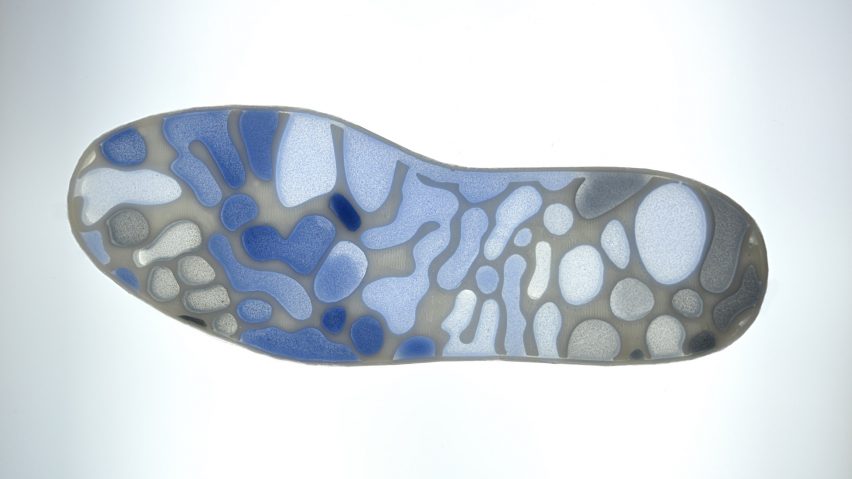Insoles that measure athletic performance using bacteria, and trainers that "breathe" are among the latest experimental pieces of sportswear being developed by Puma and MIT Design Lab.
Debuted during Milan design week, the Biodesign: Living and Breathing the Future of Performance project features four cases that test how bacteria could be used within sportswear design to improve performance and sustainability.
Sportswear brand Puma and MIT Design Lab – an interdisciplinary research laboratory at the Massachusetts Institute of Technology – created the exhibition with design studio Biorealize.
"We see the future of athletic gear to be real-time adaptive to the biology of the user and to the active environment," said MIT Design Lab director Yihyun Lim.
The Breathing Shoe is a trainer that changes in response to the biology of the wearer. The upper is made from a material moulded to include cavities that are filled with bacteria. Responding to heat generated by the wearer, the bacteria eats away at the material to create a unique pattern of air passages.
Also on display were Deep Learning Insoles (main picture) that could collect biological information about the wearer by using bacteria that responds to chemicals in sweat both in the short-term and long-term. The changes would be detected by a layer of electronic circuits, and turned into data that is transmitted using micro-controllers.
This data could then be used to measure fatigue among other factors.
"[Biodesign can] provide a new way of engaging with materials, a self-assembly of material, where bacteria can be responsible for completing the manufacturing of the shoe, where the whole experience of the shoe becomes complete when it interacts with the human body," said Lim.
"We are imagining products that can adapt to users and the environment in real time, without the user having to do anything, [to] optimise their movement, body and their performance. Products will behave on behalf of the athlete, in real time and effortlessly."
The exhibition also included the Carbon Eaters T-Shirt that features a small round button containing organisms that respond to carbon in the air, changing colour to indicate air quality and the presence of high levels of substances that might affect performance.
Finally, Adaptive Packaging looks beyond products that are worn to the way they are delivered to the user, envisioning a scenario where biomaterials could be used to create packaging sleeves that inflate by emitting gasses in response to a heat.
The packaging expands to fit around the product placed inside, and has a built-in lifespan that means it eventually self-degrades, leaving no physical waste.
"Through these organism-enhanced products we aim to create a stronger link between the user and the environment, by bringing awareness to the invisible organisms that are supporting our life cycle," said Lim.
"Through this perhaps we can cultivate an emotional relationship with our products, a new user-centred experience where our organism-enhanced products become our ‘pets’, where it needs to be caressed and taken care of."
The Biodesign research project forms the second year a four year collaboration between MIT Design Lab and Puma’s Innovation team called Adaptive Dynamics, which aims to investigate ways that responsive and adaptive technologies might influence the future of sportswear.
Previous experiments have focused on sensors and digital fabrication.
The four test cases shown in Milan were created with Biorealize, a biotech start-up from the University of Pennsylvania that focuses on developing tools for enabling biological design projects.
"Biodesign opens up a new area of research and potentials for creating new kind of wearable; using live organisms to sense and respond to the individual user and also to the surrounding environment," said Lim.
"In the current product experience, customisation happens prior to actual use. With Biodesign we see this user-led upgrade and customisation to occur throughout the product experience."
Founded in 2006 by William J. Mitchell and Federico Casalegno, MIT Design Lab is a multidisciplinary organisation within that focuses on the potential of new technologies to tackle social, economic and cultural problems.
In 2015, MIT Media Lab, another multidisciplinary organisation at MIT, teamed up with the Royal College of Art to create a "bio-skin" fabric called BioLogic that could peel back in response to sweat and humidity.
Designer and materials researcher Shamees Aden has also developed shoes with self-regenerating running shoes using protocells – synthetically produced cells that can respond to environmental conditions.
Images courtesy of MIT Design Lab, powered by Biorealize.

